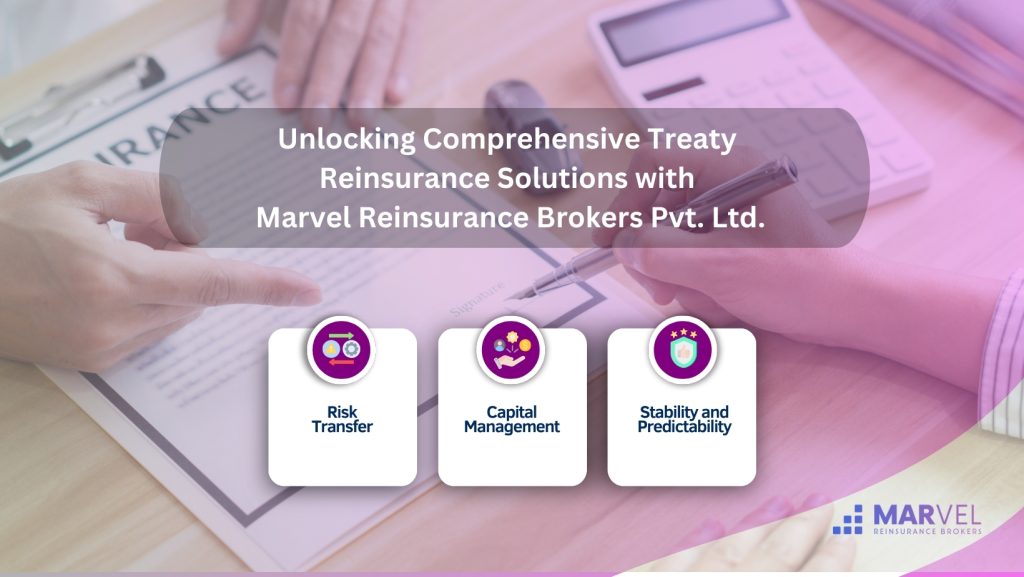
Treaty reinsurance serves as a cornerstone of the insurance industry, facilitating the transfer of risk from primary insurers to reinsurers. At Marvel Reinsurance Brokers Pvt. Ltd., we recognize the critical role that treaty reinsurance plays in enhancing insurers’ risk management capabilities, optimizing capital utilization, and fostering stability in an ever-evolving market landscape. In this comprehensive guide, we explore the intricacies of treaty reinsurance, including its types, benefits, challenges, and significance, offering insights into how insurers can leverage these solutions to achieve their strategic objectives.
Types of Treaty Reinsurance
Proportional Reinsurance: Proportional reinsurance, also known as pro-rata reinsurance, involves the sharing of premiums and losses between the primary insurer and the reinsurer based on a predetermined percentage. This arrangement enables insurers to transfer a portion of their risks to reinsurers while maintaining a proportional share of the premiums and losses. Within proportional reinsurance, various structures exist:
- Quota Share Reinsurance: Under Quota share reinsurance, the primary insurer concedes a fixed proportion of each policy it underwrites to the reinsurer. This arrangement allows insurers to spread their risks across multiple parties, resulting in more predictable underwriting results and enhanced capital efficiency.
- Surplus Reinsurance: Surplus reinsurance, also known as quota share in excess of loss, provides coverage for losses that exceed a predetermined threshold. Insurers retain a portion of the risk, up to a specified limit, and transfer the excess to the reinsurer. This type of reinsurance offers insurers flexibility in managing their risk exposure while protecting against large or unexpected losses.
Non-Proportional Reinsurance: Non-proportional reinsurance, also referred to as excess of loss reinsurance, comes into play when losses exceed a predefined threshold. Unlike proportional reinsurance, where the reinsurer shares risks based on a predetermined percentage, non-proportional reinsurance provides coverage only for losses that surpass a specified amount. Non-proportional reinsurance encompasses several categories:
- Risk XL Reinsurance: Risk XL reinsurance offers coverage for large and complex risks that fall outside the scope of traditional reinsurance programs. This type of reinsurance provides insurers with additional capacity and protection against catastrophic events, allowing them to safeguard their balance sheets and maintain financial stability.
- CAT XL Reinsurance: CAT XL reinsurance provides coverage for losses resulting from catastrophic events such as natural disasters, severe weather events, or other major perils. This reinsurance helps insurers to mitigate the financial impact of catastrophic events and ensure continuity of operations in the aftermath of such events.
- Stop Loss XL Reinsurance: Stop Loss XL reinsurance offers protection against adverse loss trends or unexpected fluctuations in claims experience. Insurers can establish stop loss provisions to limit their exposure to losses beyond a certain threshold, providing them with greater certainty and stability in their underwriting results.
- Spill Over XL Reinsurance: Spill Over XL reinsurance provides insurers with additional capacity to absorb losses beyond their retained limits. This type of reinsurance offers an extra layer of protection against unforeseen events or extreme market volatility, allowing insurers to enhance their risk management capabilities and maintain financial resilience.
MarvelRe excels in providing tailored proportional reinsurance solutions, ensuring our clients benefit from optimal risk distribution and enhanced financial resilience and specializes in crafting customized non-proportional reinsurance solutions, offering our clients additional capacity and protection against catastrophic events.
Benefits of Treaty Reinsurance
Treaty reinsurance offers several benefits to both primary insurers and reinsurers:
Risk Transfer: One of the primary advantages of treaty reinsurance is risk transfer. By ceding a portion of their risks to reinsurers, primary insurers can reduce their exposure to large losses, thereby enhancing their financial stability and solvency.
Capital Management: Treaty reinsurance enables primary insurers to optimize their capital utilization by freeing up capital that would otherwise be tied up in reserves to cover potential losses. This surplus capital can then be reinvested in the business, supporting growth initiatives or improving profitability.
Stability and Predictability: Proportional reinsurance provides stability and predictability to primary insurers by spreading risks across multiple parties. This ensures a more consistent flow of premiums and claims, minimizing the impact of adverse events on the insurer’s financial performance. Non-proportional reinsurance, on the other hand, offers protection against catastrophic losses, safeguarding the insurer’s balance sheet and preserving its ability to honor policyholder claims.
MarvelRe stands out in facilitating seamless risk transfer processes, guiding our clients in unlocking surplus capital and maximizing growth opportunities by providing stability-focused reinsurance solutions.
Challenges and Considerations
While treaty reinsurance offers numerous benefits, it also presents certain challenges and considerations for both primary insurers and reinsurers:
Underwriting Discipline: Treaty reinsurance can potentially encourage lax underwriting standards among primary insurers, especially when they rely heavily on reinsurers to absorb their excess risks. This could lead to adverse selection and moral hazard issues, where insurers may take on riskier policies without adequately assessing the associated liabilities.
Counterparty Risk: Primary insurers are exposed to counterparty risk when entering into treaty reinsurance agreements. The insolvency or financial instability of the reinsurer could jeopardize the insurer’s ability to recover claims in the event of significant losses.
Regulatory Compliance: Treaty reinsurance arrangements are subject to regulatory oversight to ensure compliance with applicable laws and regulations. Insurers must adhere to regulatory requirements concerning capital adequacy, risk management, and financial reporting when engaging in reinsurance transactions.
Significance of Treaty Reinsurance
Treaty reinsurance plays a crucial role in the insurance industry ecosystem, contributing to its stability, resilience, and capacity to absorb risks:
Risk Mitigation: Treaty reinsurance enables insurers to diversify their risk exposure across different geographies, lines of business, and perils. By spreading risks across a broader portfolio, insurers can mitigate the impact of localized events or sector-specific downturns, enhancing their overall risk management capabilities.
Market Capacity: Treaty reinsurance expands the capacity of the insurance market to underwrite large and complex risks. Reinsurers, with their substantial capital base and risk-bearing capacity, provide primary insurers with access to additional capital and expertise to handle risks beyond their individual capabilities.
Financial Stability: The presence of treaty reinsurance promotes financial stability within the insurance sector by buffering insurers against extreme or unforeseen losses. Reinsurers absorb a significant portion of catastrophic risks, reducing the likelihood of systemic shocks that could destabilize the entire industry.
Conclusion
Treaty reinsurance serves as a vital tool for insurers to manage their risk exposure, optimize capital utilization, and enhance financial stability. Whether through proportional or non-proportional arrangements, treaty reinsurance offers insurers a means to transfer risks, protect against catastrophic events, and navigate regulatory challenges effectively. With MarvelRe, as their trusted partner, insurers can leverage our expertise and market relationships to design tailored reinsurance solutions that meet their specific needs and drive sustainable growth in an increasingly complex risk landscape. Contact us today to learn more about how our treaty reinsurance solutions can benefit your organization and help you achieve your strategic objectives with confidence.

